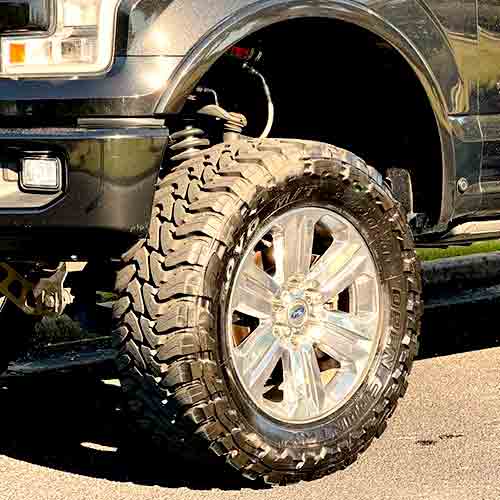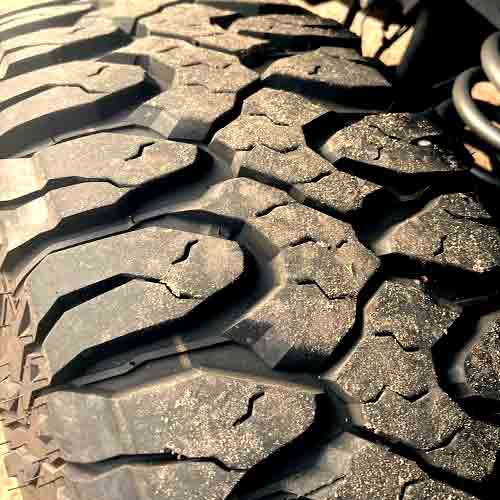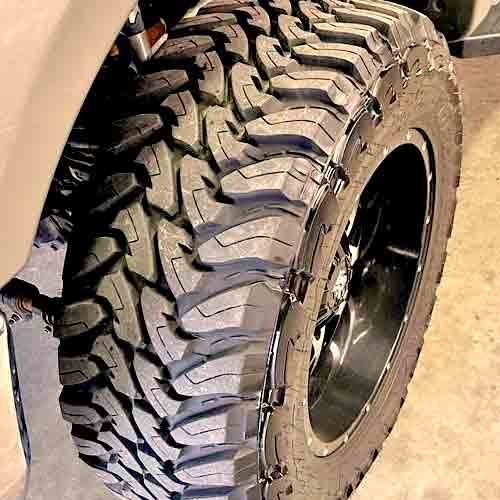Commercial traction is not a problem with both Milestar Patagonia and the Toyo MT, as they offer innovative tread compounds that bring a favorable experience to truck owners. Though there are still a few things you should know about them.

As a tire designer/engineer, my tests conclude that the Milestar M/T features a relatively superior traction on sandy terrains off roads, and comes out on top in terms of fuel economy, impact comfort, and wet traction on highways. The Toyo Open Country M/T on the other side features a durable compound so it’s rocky and muddy terrain performance is better. Moreover, it also delivers longer tread life and a quieter ride on roads.
Table of Contents
Tread Differences
Let me start off with the Milestar Patagonia MT.

This tire is very well structured, as the central part of its tread offers both lateral and directional grip. Let me explain how.
So here basically you get U shaped blocks, with sharp edges and chamfered sides, these deliver off road traction, and as these lugs are closed up together, forming smaller grooves in between, they render consistent contact with the road, (relatively), resulting in grip.
Moving towards shoulders, the lugs there are joined up together on the sidewalls supplying lateral stability.
And with multiple notches, staggered edges and stone ejectors, they yield decent bite and self cleaning abilities.
Moreover, the sidewall lugs also have multiple functions, as they offer protection to the weakest part of the tire and at the same time, enhance their footprint with lowered air pressure, giving traction on softer surfaces such as sand and mud.
On the other side, the Toyo M/T features a 4 rib structure instead of 3, seen on it’s competitor.

Its middle area comes with 3 very tough passing circumferential grooves.
They contain hook shaped blocks with sharp chamfered edges, notches and full depth sipes.
With their closed up arrangement (compared to outer section), they offer decent on-road grip, especially on highways, where the tire moves directionally.
Moreover, adding to that are its reinforced foundational supports, which aids overall stability of these lugs.
The shoulder lugs are the biggest, or should I say elongated. They although have similar siping, and their edges are smoother in comparison.
Furthermore, like its counterpart, shoulders make staggered outer edges, with mud scoops, connected with (N shaped) sidewall lugs.
Off-Road Performance
Off-road tires must be able to clean themselves effectively and be durable to perform well on various terrains. Let’s examine all of these factors.
On Mud
Mud is where these tires do their best. But still is one better than the other?
Well, yes, my testing shows me that the Toyo M/T comes out on top on all sorts of muddy terrains.
It’s basically comes with greater weight (which is actually better for muddy tracks), and it’s offers much better pathways for superior evacuation.
The Milestar Patagonia MT on the other side, has central rib causing it most of the trouble. It literally comes in the way of mud, disallowing them to efficiently leave out through sideways.
On Sand
The less digging the tire does on sand the better and so both weight and tread structure come in to action here.
The Toyo Open County MT is heavier in comparison, and even though it’s lugs on sidewalls are better, forming good enough footprint, the tire can’t still stay afloat as better as its counterpart.
Milestar Patagonia MT on the other side, features softer rubber and smoother outer edges, and so its able to create forward momentum better.
Side Note: One of the best tires for sand is BF Goodrich KM3. (You can find its review with the help of search bar).
On Rocks
Both tires simply are awesome on rocks. They hold on to all kinds of rocky surface, like there’s no tomorrow.
In case of Toyo M/T, the tire features a soup of circumferential and lateral traction with it’s countless biters everywhere. And it’s side biters are although not as flexing, that’s not an issue, when you lower the air pressure on this tire, enhancing its flexibility.
The Milestar Patagonia MT on the other side, supply amazing lateral traction with it’s sidewall lugs, especially on wet rocks.
Furthermore, the tire’s extended shoulder lugs give out a noteworthy footprint connecting with the rocky surface, (when pressured down), where it’s deep biters ensure the grip is also firm enough.
Street Performance
The overall tire’s footprint is a very important factor that impacts grip, though others include the tire’s weight, and rubber compositions.
Considering all these factors, you see quicker stopping on Milestar Patagonia MT (braking distance measures directional grip).
It simply put offers a lot more contact patch with it’s compacted lugs placement, especially in the middle. It’s single rib design with C shaped lugs have smaller lateral gaps in between, and they stay more connected with surface.
Moreover, the tire is also much lighter and comes with shorter tread depth. Both of these offer quicker response times, and steering sensitivity, relatively.
Wet Traction
Wet performance is divided in to 2 areas, where one is the tire’s overall architecture, and the other is the wet grip which depends siping a lot.
And yes, there’s hydroplaning too, which I’ll discuss at the end.
Wet Grip
Wet traction is the worst performance area for mud terrain tires. This is because these tires aren’t able to wipe water off (on a smaller scale) that effectively.
So on roads, water has to be cleared out, otherwise tread won’t be able to grip in. This is because water is not compressible.
And although M/T tires are bald enough to channel most of that water out through tread voids, the little that’s left behind still causes issue, as that has to be cleared off with sipes.
Now as for the siping goes, both tire have ample of those (considering other mud tires), but the overall gripping is still seen better on Milestar Patagonia MT, due to its softer compound.
Sipes work by flexing, which create suction, and water particles are soaked up in their slits.
And the Toyo Open Country with a much more rigid tread composition, can’t allow those sipes to effectively wipe water away.
Hydroplaning
Hydroplaning resistance is also a vital part of wet traction where it takes the load off sipes, by expelling water off, so that less gets remained behind for the sipes to clear.
And with wider channels, the Toyo Open County MT is very efficient at escaping water out, as it offers decent float speeds, taking in to account, it’s a Mud-Terrain.
Float speed is the measurement of how fast a tire can go over water without creating a thin layer of it between the tread and the ground.
The Milestar Patagonia MT is slightly lacking here, as it doesn’t offer as great of float speeds, especially when it corners. This is due to it’s closed up central rib, which restricts the lateral movement of the water, relatively.
Fuel Consumption
The fuel efficiency of a tire is affected by its rolling resistance, which is then dependent on the tread depth, composition, and the tire’s overall structural weight.
And here the Milestar Patagonia MT gives out better Miles per gallon. And that’s simply put, is because of its smaller weight, which needs less energy to be carried around.
The Toyo M/T not only weighs more, but it’s central area is also not that streamlined in to moving straight, so it lacks in fuel economy on highways.
Tread Life
When it comes to tread wear the tire’s rubber and weight has a huge role to play.
Now Milestar M/T may have smaller weight (on average, considering all sizes), and it may produce lower rolling resistance values, but its lacking in the tread-wear department, overall.
Let me explain why.
You see the Toyo M/T features a much more durable rubber construction, with Kevlar reinforcements, that is less susceptible to burning that quickly.
Furthermore, it’s tread depth is also greater on average (again considering all sizes), so it take longer to wear down to the depth, where its time to change.
Ride Comfort
Ride quality has a lot of variables. One of them is the settling of the bumps and vibrations on roads. And here, the Milestar Patagonia MT with it’s malleable compound, and larger tread depth cushions the imperfections of the road in a better way.
Moreover, its comparatively less voided design, offers a stable maneuverability on smooth tracks, in comparison as well.
The Toyo M/T on the other side, renders a jittery ride with its much more rigid tread compound.
Though, the tire is quieter overall, and that’s also a important part of overall ride comfort.
Noise works by air particles hitting the walls of the tread, and Toyo M/T features superior variable pitch technology to handle that.
Winter Traction
And let me tell you this first, for mud tires, ice and hard packed snow is a big NO. But sure you can work with these tires on deeper snowy tracks, which you may also call “off-road snow”.
That’s why both tires are just M+S and not 3 peak mountain snowflake rated, in fact, there’s isn’t a single mud-terrain tire with 3pmsfr.
Nonetheless, out of our tires here, you are better off with Milestar Patagonia MT.
That’s because with thermal adaptive rubber, its gets to put it’s biters to test, whereas the Toyo M/T freezes up more quickly with extreme winter temperatures.
Conclusion
Although bypassing the previous content isn’t recommended, as it’s the result of rigorous research, I understand that some readers may be short on time. Here’s a concise breakdown of everything I discussed.
The Toyo Open Country M/T outperforms its competitors in these specific areas of performance.
- Mud grip.
- Rocky terrain traction.
- On-road noise.
- Tread life.
On the other hand, the Milestar Patagonia MT offers better;
- Wet grip.
- Fuel economy.
- Winter traction.
- Impact comfort.
- And sand traction.